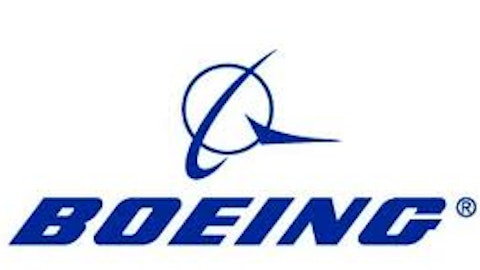It’s earnings season, and for defense stocks, investors will be looking at how defense-spending cuts are affecting defense companies’ profits. Yet there’s one defense giant for which investors will be more concerned about commercial profits than government profits. I’m talking about The Boeing Company (NYSE:BA), and, more pointedly, why commercial airline sales, such as for the 787 Dreamliner, have such a massive impact on Boeing’s stock.

Photo: Dave Sizer, via Wikimedia Commons.
Money, money, money
As defense contractors go, The Boeing Company (NYSE:BA) is one of the largest defense companies in the world — it’s second only to Lockheed Martin Corporation (NYSE:LMT) in terms of revenue. But,where Lockheed Martin Corporation (NYSE:LMT) gets an estimated 95.1% of its revenue from defense, The Boeing Company (NYSE:BA) only gets 38.4% from defense. The rest comes from commercial sales.
A large portion of that commercial revenue comes from commercial airline sales. In fact, there’s an estimated $100 billion-a-year jet market, for which a number of plane manufacturers compete. However, in the midst of that competition, The Boeing Company (NYSE:BA) is one of the top dogs and really sees major competition only from European Aeronautical Defense and Space‘s Airbus. The rivalry between these two giants is intense, to say the least, because commercial airline revenue has a key impact on the companies’ bottom line.
Case in point: In its quarterly report, released on Wednesday, The Boeing Company (NYSE:BA) stated that it received $40 billion in new commercial aviation orders, beat projected profits, increased full-year-revenue guidance, and increased its operating margin for commercial airline production to 10.7 — up from 10.2 during the same time last year. Furthermore, commercial aviation revenue rose 15%, while defense revenue remained flat. Following this news, The Boeing Company (NYSE:BA)’s stock soared. Clearly, commercial aviation revenue is paramount to Boeing’s bottom line.
What to watch
Boeing has a number of lucrative planes available for commercial sale, but one that investors should keep especially close tabs on is the Dreamliner. It represents an evolution in aviation technology and is also Boeing’s next-generation plane that airlines look at when they’re going for modernization and improved fuel economy. For example, at this year’s Paris Air Show, GE Capital Services, British Airways plc (ADR) (OTCMKTS:BAIRY), Air Lease Corp (NYSE:AL), United Continental Holdings Inc (NYSE:UAL), and Singapore Airlines Ltd. (SGX:C6L) all placed orders for the 787-10 version of the Dreamliner — which amounted to $30 billion in sales.
Right now, the Dreamliner’s main competition is Airbus’ A350. Both planes are next-gen, medium-sized planes, built for long-haul flights, and come with the bonus of improved fuel savings. Also, the A350 took its maiden voyage at this year’s Paris Air Show — and now that it’s flying and not just a concept, Airbus’ A350 will become more of a threat to Boeing’s Dreamliner sales. Still, Boeing maintains that the Dreamliner gets better gas mileage, but Airbus counters the claim by saying the A350 is quieter and has lower operating costs.
What will happen with Dreamliner sales vs. A350 sales is anyone’s guess. But considering how the Dreamliner affected Boeing’s stock when it was grounded, and again when it was released from that grounding, investors should keep a close eye on the growing competition between the A350 and Dreamliner.
The article The Hidden Factor Behind Boeing’s Massive Profits originally appeared on Fool.com is written by Katie Spence.
Fool contributor Katie Spence has no position in any stocks mentioned. Follow her on Twitter: @TMFKSpence. The Motley Fool owns shares of Lockheed Martin.
Copyright © 1995 – 2013 The Motley Fool, LLC. All rights reserved. The Motley Fool has a disclosure policy.





